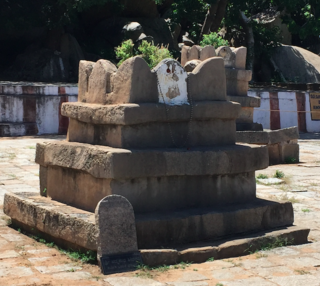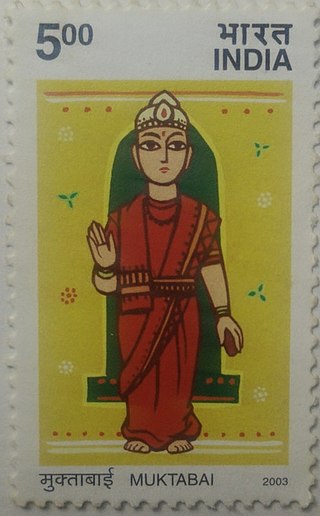Paithan ['pəɪ.ʈʰaɳ], historically Pratiṣṭhāna [pɾə'tɪʂʈʰana], is a town with municipal council in Aurangabad district, Maharashtra, Maharashtra, India. Paithan is located 56 kilometres (35 mi) south of present-day Chatrapati Sambhajinagar on the banks of the Godavari River. It was the capital of the Satavahana dynasty, which ruled from the second century BCE to the second century CE. It is one of the few inland towns mentioned in the famous first-century Greek book, the Periplus of the Erythraean Sea.

Koodli, also spelled Kudli or Kudali, is a small historic village in Shimoga District, in the Indian state of Karnataka. It is at the sangam (confluence) of two rivers, the Tunga River and Bhadra River at nearly 1,200 metres (3,937 ft). They meet here to give rise to the Tungabhadra River, a tributary of the Krishna river. Their valleys host many architectural sites. The village was a much larger town and pilgrimage center before the 14th-century, one destroyed during the Islamic conquests of the south. Important temples and their ruins here include the Dakshinamnaya Moola Sringeri Sharada Peetham, Sangamesvara temple, Ramesvara temple, Sri Chintamani Narasimha temple, Sringeri Vediki temple, Vishwakarma temple, Sharadamba temple, Amma Devasthana, and the Brahmeswara temple. Other scattered ruins of unknown temples are also found here.

Sri Jayatirtha, also known asTeekacharya, was a Hindu philosopher, dialectician, polemicist and the sixth pontiff of Madhvacharya Peetha from. He is considered to be one of the most important seers in the history of Dvaita school of thought on account of his sound elucidations of the works of Madhvacharya. He is credited with structuring the philosophical aspects of Dvaita and through his polemical works, elevating it to an equal footing with the contemporary schools of thought. Along with Madhva and Vyasatirtha, he is venerated as one of the three great spiritual sages, or munitraya of Dvaita. Jayatirtha is considered an incarnation of Indra with avesha of Adi Sesha in the Madhva Parampara.
Vaijapur is a city and a municipal council in Aurangabad district in the Indian state of Maharashtra. It is bordered by the Nashik districts to the west, Kannad tehsil to the north, Gangapur tehsil to the east, and Ahmednagar districts to the south. Vaijapur is the headquarters of Vaijapur tehsil and also known as the Gateway of Marathwada.

Puntambekar is an Indian surname. It is found amongst Marathi speaking Deshastha Brahmin and Karhade Brahmin communities of Maharashtra. Marathi surnames are created by adding the suffix -kar to the family's town of origin; therefore, people originating from the town of Puntamba take the name Puntambekar.

Padmanabha Tirtha was an Indian Dvaita philosopher, scholar and the disciple of Madhvacharya. Ascending the pontifical seat after Madhva, he served as the primary commentator of his works and in doing so, significantly elucidated Madhva's terse and laconic style of writing. His pioneering efforts in expanding upon the Dvaita texts to uncover the underlying metaphysical intricacies was taken forward by the 14th Century philosopher, Jayatirtha. Padmanabha is also credited with disseminating the philosophy of Dvaita outside the Tulunadu.

Sadh Vaishnavism, , is a denomination within the Vaishnavism—Bhagavata tradition of Hinduism. Sadh Vaishnavism was founded by thirteenth century philosopher-saint Madhvacharya, who developed the Tattvavada (dvaita) Vedanta sub-school of Hindu philosophy.

Changdev Maharaj was a mystical yogi turned saint who is believed to have lived in the village of Vateshwar along the banks of the Tapti River for 1,400 years. Per popular belief, Changdev Maharaj achieved Bhuta Siddhi based on his yogic powers and used these powers to perform various supernatural acts. Even though Changdev Maharaj himself is believed to have had held godly status and followers, his current following is mostly amongst Varkaris due to his association with Dnyaneshwar and Muktabai.
Nivruttinath was a 13th-century Marathi Bhakti saint, poet, philosopher and yogi of the Vaishnava Nath tradition. He was the elder brother and the mentor (guru) of Dnyaneshwar, the first Varkari saint.

Muktabai or Mukta was a saint in the Varkari Movement. She was born in a Deshastha Brahmin family and was the younger sister of Dnyaneshwar, the first Varkari saint. She wrote forty-one abhangs throughout her life.

The Uttaradi Math, is one of the main monasteries (matha) founded by Madhvacharya with Padmanabha Tirtha as its head to preserve and propagate Dvaita Vedanta (Tattvavada) outside Tulunadu region. Uttaradi Math is one of the three primary Dvaita monasteries or Mathatraya that descended from Madhvacharya in the lineage of Padmanabha Tirtha through Jayatirtha. After Jayatirtha and Vidyadhiraja Tirtha, Uttaradi Math continued in the lineage of Kavindra Tirtha and later in the lineage of Vidyanidhi Tirtha. The Mūlarāmā and Mūlasītā idols worshipped in the Uttaradi Matha have a long history and are revered among adherents.

Sri Satyatma Tirtha, is an Indian Hindu philosopher, guru, scholar, spiritual leader, saint and the present pontiff of Uttaradi Math. He is the 42nd pontiff of Uttaradi Math since Madhvacharya, the chief proponent and the one who rejuvenated the Dvaita philosophy (Tattvavada). Satyatma Tirtha founded Vishwa Madhwa Maha Parishat, a non-profit, religious and social organization in 1998.
Veeracholapuram is a village located near Viluppuram in Viluppuram district, Tamil Nadu, India.
Shakala Shaka, is the oldest shakha of the Rigveda. The Śākala tradition is mainly followed in Maharashtra, Karnataka, Kerala, Odisha, Tamil Nadu and Uttar Pradesh. The Mahābhāṣya of Patanjali refers to 21 śākhās of the rigveda; however, according to Śaunaka's Caraṇa-vyuha there are five śākhās for the Rigveda, the Śākala, Bāṣkala, Aśvalayana, Śaṅkhāyana, and Māṇḍukāyana of which only the Śākala and Bāṣkala and very few of the Aśvalayana are now extent. The only complete recension of this text known today is of the Śākala School. As far as the Rigveda is concerned only Śākala Śākhā is preserved out of 21 which existed at one time. There is a claim that Śaṅkhāyana Śākhā is still known to a few Vedapathis in Uttar Pradesh and Gujarat but this is not certain.

Shri Vidyadhisha Tirtha, was an Indian philosopher, scholar, theologian, saint and dialectician. He served as the sixteenth pontiff of Uttaradi Math from 1619 to 1631. He is considered to be one of the important stalwarts in the history of Dvaita school of thought on account of his sound elucidations of the works of Madhvacharya, Jayatirtha and Vyasatirtha. He is also the most celebrated pontiff of Uttaradi Math after Padmanabha Tirtha, Jayatirtha and Raghuttama Tirtha.

Satyanidhi Tirtha was a Hindu philosopher, scholar and saint. He served as the pontiff of Shri Uttaradi Math from 1638–1660. He was the 19th in succession from Madhvacharya. Satyanidhi Tirtha ruled the pontificate with a remarkable distinction. His life was a saga of supreme spiritual achievements.

Satyadhyana Tirtha was an Indian Hindu philosopher, scholar, yogi, mystic, theologian and saint. He was the 38th pontiff of Uttaradi Math and served the pontificate from 1911-1942. He was considered most active and zealous pontiffs of 20th century. He was an untiring propagandist, the best debater of his days and almost a terror to his adversaries in philosophical polemics. It was at his initiative and inspiration that a splendid Marathi translation of Madhva's Brahmasutra Bhashya, with the Tatvaprakashika of Jayatirtha was published for the benefit of a large number of followers of Madhvacharya in Maharashtra. He made extensive tours all over India, held disputations and published polemical tracts and phamplets in many languages in North and South India for free distribution. He started, Sriman Madhva Siddhanta Abhivruddhikarini Sabha around 1905-06 and registered in 1930 to promote the study of Sanskrit literature and philosophy, particularly the study of Dvaita Philosophy, to hold meetings and conferences of Madhva scholars.

Satyabodha Tirtha was an Indian philosopher, scholar, yogi, mystic and saint. He was the 25th pontiff of Uttaradi Math and served the pontificate from March 1744 - 9 March 1783. Satyabodha Tirtha was a great yogi and was honoured by both Hindu and Muslim rulers of his time. Satyabodha Tirtha enjoyed a good fame as a miracle-man. Almost all the princes of the South India used to worship him and were his ardent disciples. Murari Rao of Gooty, Raghoji Bhosale and Fateh Singh Rao Gaekwad, were his great disciples. Satyabodha Tirtha Swamiji's mission of peace has played a prominent role during this time. He earned a reputation as the greatest of Madhva saints of his time for his un-rivaled scholarship, miraculous achievements and dynamism as the pontiff of the Uttaradi Math. So many were his achievements and so well was he liked, admired and respected by people of all castes and creeds, rich and poor, that the Uttaradi Math in Savanur got the name as Satyabodha Math after him. Satyabodha Tirtha is believed to be the incarnation of Markandeya.

Satyapurna Tirtha, , was a Hindu philosopher, scholar and saint. He served as the pontiff of Shri Uttaradi Math from 1706 to 1726. He was the 22nd in succession from Madhvacharya. Satyapurna Tirtha ruled the pontificate with a remarkable distinction. His life was a saga of supreme spiritual achievements.
Madhva Vaishnavas or Sadh Vaishnavas or Madhvas are Hindu communities in India, who follow Sadh Vaishnavism and Dvaita philosophy propounded by Madhvacharya. They are found mostly in the Indian states of Karnataka, Maharashtra, Goa, Tamil Nadu, Kerala, Telangana and Andhra Pradesh.
















